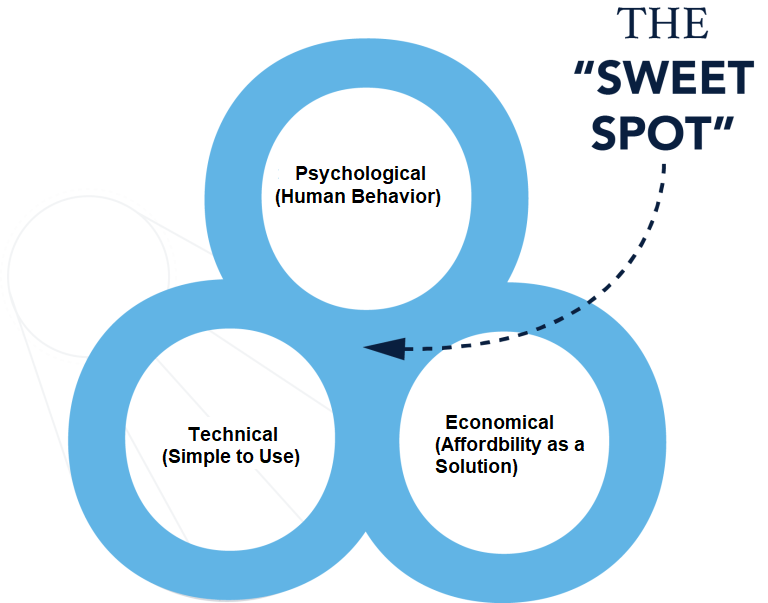Have you ever wondered why some companies are so good and knowing what their “sweet spot” is? What is it that they do to figure that out? Below are a few key things to consider when trying to find your sweet spot in business. Get some tips on how you can find your sweet spot in business to better connect and relate with your customers. It could provide increased sales, better reviews, and overall improved customer satisfaction.
Finding the Sweet Spot in Business
Re-framing Questions
Reframing is a way of viewing and experiencing events, ideas, concepts and emotions to find more positive alternatives or even turning something upside down so you can see it for what it is or isn’t.
Think about how to solve customer problems. For instance, if you want to get people to finish their antibiotics, what is a possible solution? One way is to give them 18 white and 6 blue pills, and tell them to take all white pills first and the blue ones last. There is a increased likelihood that they will finish the entire bottle.
The power of reframing things can’t be overstated. One activity or product might make you feel terrible, but the by changing one small thing might make you feel amazing. If you want to design cutting edge brand identities, products or campaigns, then thinking about how to reframe is a viable way to make an impact.
It may seem that big problems require big solutions, but Rory Sutherland says “…many flashy, expensive fixes are just obscuring better, simpler answers.”
Years of marketing says if you want people to remember you and appreciate what you do, the most memorable things are actually very very small. Virgin Atlantic, for example, created salt and pepper shakers shaped like airplane engines. Details of usability are key. This trivial marketing example is a way to reframe the experience. It can make a difference in just how memorable the perceived value of your product is.
The Sweet Spot
In our efforts to explore hidden depths to solve customer problems and come up with products that perform, we often end up focusing more on shallow impressions. This is why solutions need to be more balanced. It is important to consider the three factors of an idea that affect how people make decisions. These three factors are psychological, technical, and economical. It is more about focusing on the “sweet spot” in business, which is somewhere in the middle of all three.
Psychological factors are about knowing what people care about, what motivates and triggers them. It is really tapping into their emotional brain, where the features and functions may not matter as much as the benefits. Whether you introduce fear or certainty, doubt or conviction, how a company taps into this will determine its success.
Technical factors around an idea are more about how you can mitigate risk and ensure there is proper support. It really needs to solve the problem, be reliable, and scalable.
Economical factors are related to the current and expected future value of the business idea. These factors could include labor costs, mobility, policy, management, design and a variety of other associated costs.
A good example of finding that “sweet spot” in business is putting display boards on train platforms or on freeways, showing people how long they have to wait before the train arrives or before they get to their destination. It solves that problem we have with uncertainty and discomfort in waiting, because our time is valuable.
Instead of Changing Reality, Change Perceptions
Advertising and online marketing adds value to a product by changing our perception, rather than the product itself. Often, a change in perceived value can be just as satisfying as what we consider “real” value. The idea isn’t to change the reality, but change the perceptions.
So much of the communication that we have is contextual, and the capacity of nudging people is pretty effortless. It is all about being contextual, timely and immediate. All these tools are at our disposal.
Triscuit wanted to re-launch one of their products in a different way. Initially, the product was sold as squares. But after some research, they simply re-marketed the product as diamonds, calling it “Diamond Shreddies”. Something as simple as the name and how it is packaged, affects how the audience reacts to them. Impressions impact how we think and what we do.
Once we begin to reframe how to come up with ideas to solve customer problems, this is when the perceived value is enhanced. For instance, if people could save time, they generally don’t like the idea of paying twice as much just to get through airport security. They would think somehow TSA purposely will cause line delays so they are forced to pay for TSA’s benefit.
But, if If we reframe this notion in a way that tells people they can get through security much faster by giving them the option to donate $X to charity, then this will likely make them feel better. Therefore, their perceived value has shifted. Donating to a good cause meets their approval, and they have some degree of affection toward it.
Final Thoughts
Don’t let your business run you. If you feel like you are scrambling to get clients, for example, then you probably are not in your sweet spot in business. The idea is to appreciate more what already exists, and find ways to make the familiar things new. Finding that sweet spot in business will make a difference on how you place a higher value on what already exists.
When you choose your frame of reference, then you can transform the perceived value.

